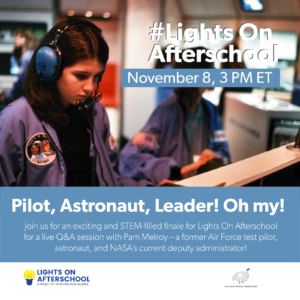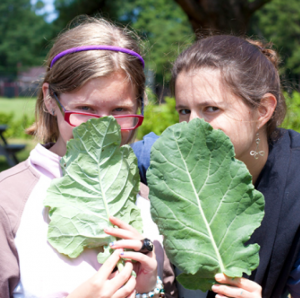Vermont Afterschool is proud to be part of the Million Girls Moonshot initiative, working to inspire and prepare the next generation of innovators by engaging one million more girls in STEM learning opportunities through OST programs over the next five years. The Million Girls Moonshot is an initiative of the STEM Next Opportunity Fund. The Million Girls Moonshot seeks to re-imagine who can engineer, who can build, who can make. See below for some information and resources that can help advance this goal!
If you are using these resources please fill out this quick survey so Vermont Afterschool can see how these resources are being distributed. Thank you!

Join Afterschool Alliance for an exciting and STEM-filled finale for Lights on Afterschool!
The STEM Next Opportunity Fund, Million Girls Moonshot and NASA are collaborating with the Afterschool Alliance to provide opportunities for students to engage with scientists and engineers contributing to NASA’s missions. On Monday, Nov. 8, at 3 p.m. ET, join them for a live Q&A session with Pam Melroy – a former Air Force test pilot, astronaut, and NASA’s current deputy administrator! Melroy is second in command at NASA and one of only two women to command a space shuttle. As an astronaut, Melroy logged more than 38 days in space as part of missions to build the International Space Station.
ACTIVITIES FOR PROGRAMS AND FAMILIES
- Student Design Activity: Bouncy Ball Factory – Youth engineer bouncy balls that meet particular criteria. Using the engineering design process, they develop and test their creations.
- Student Design Activity: Paper Table – Youth engineer a table from a newspaper that is at least 8″ high and strong enough to hold a book.
- Student Design Activity: Take Flight – Using everyday materials, youth engineer a glider that can fly straight for 15 feet.
- Student Design Activity: Keep Your Cool! Design Your Own Cooler Challenge – Youth design a cooler that will keep a bottle of water cool using the engineering design process. They test their prototype and graph their results to determine the effectiveness of the solution.
- Student Design Activity: Design a Watercraft – Youth engineering a small boat out of straws and plastic wrap that can hold weight.
- Student Design Activity: Get it Write! – Youth engineering a writing device (pen) using everyday materials. They think about both the (water soluble) “ink” and the delivery mechanism.

